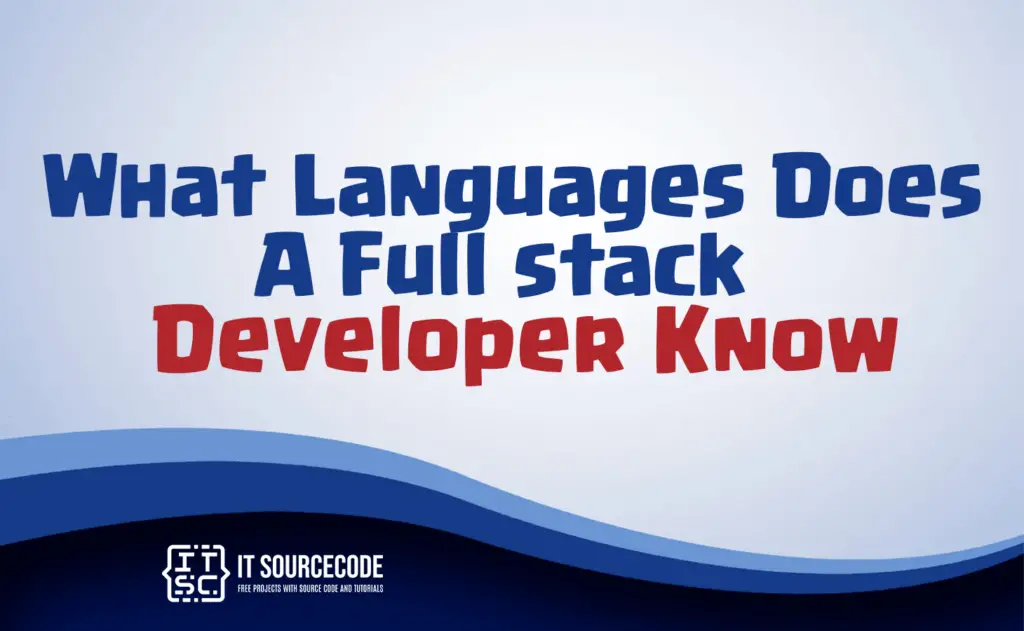WHAT LANGUAGES DOES A FULL STACK DEVELOPER KNOW – In this article, amid choices like Java, C#, Python, PHP, and JavaScript, starting full stack development can be perplexing.
A list of crucial full stack developer languages is provided to guide, leading to fulfilling careers.

Full Stack Developer Languages You Should Know
Full stack developers manage both front-end and back-end web development, including design, databases, and troubleshooting. They master multiple programming languages and use text editors like Atom and Visual Studio.
To find the best developer, consider their language proficiency. Let’s begin.
HTML & CSS
HTML is used for creating web pages with text, audio, and more, interpreted by browsers. HTML5 enhances this with offline capabilities and better graphics. CSS complements HTML by controlling a page’s appearance.
It’s like colors for lego bricks, making sites elegant and is vital for web development. Proficiency in HTML, CSS, and more is crucial for sought-after full stack developers.
JavaScript
JavaScript is pivotal for front-end development, enhancing user interfaces and powering sites like YouTube and Facebook. It enables animation, content updates, and data manipulation. It’s a must-know for full-stack developers, offering versatility for server-side programming through NodeJS.
JavaScript elevates webpage interactivity with effects, attracting traffic. Proficiency in JavaScript is sought after by companies aiming for appealing, interactive websites.
Python
Python is a favored back-end language for full stack developers due to its versatility in various fields, including Machine Learning and web development. Its English-like syntax makes it beginner-friendly.
The Django framework, built with Python, is user-friendly and used by companies like Spotify and Mozilla. Python’s simplicity and flexibility suit academic, research, and scientific applications, as well as cybersecurity tasks.
MEAN
MEAN is a popular web framework stack for full-stack developers, consisting of MongoDB, Express.js, AngularJS, and NodeJS, all based on JavaScript. It simplifies development, covering databases, web apps, front-end, and back-end. MEAN’s efficiency is favored by companies like Amazon and Google.
PHP
PHP functions as a scripting language on the server side, employed in web development to oversee interactions with web servers and databases. Its adaptability is a result of its alignment with HTML.
Full-stack developers benefit from its open-source nature and community support, using it for web-based apps, advertising, and media.
Ruby
Ruby is a dynamic language with a user-friendly interface, great for creative web development. Its simplicity attracts developers for mobile and web apps.
Full-stack devices use it for social platforms, online stores, and major sites like Shopify and Instacart. Ruby’s predictiveness enhances productivity.
Perl
Perl is an interpreted language suited for text processing in web development. Frameworks like Dancer and Catalyst simplify deployment. Its text handling and integration capabilities make it useful.
C++
C++ is beginner-friendly, object-oriented, and portable. It’s valuable for full stack web developers due to code reusability and high performance. Suitable for server-side web development tasks.
SQL
SQL is used by web developers to access data from databases like Oracle, MySQL, and Sybase. Full-stack developers employ SQL to manage data in relational databases, creating rules for storage and access, enhancing communication between backend components.
FAQs
What languages does a full stack developer need to know?
A full stack developer should know front-end languages like HTML, CSS, and JavaScript, along with various back-end languages such as Python, Ruby, Java, PHP, and more.
Is it necessary to learn multiple programming languages as a full stack developer?
Yes, learning multiple languages is important as they have distinct roles in web development, enabling versatility and efficiency.
Can a full stack developer specialize in just one programming language?
While possible, full stack developers are expected to be well-versed in multiple languages to handle both front-end and back-end tasks effectively.
What are some commonly used back-end languages for full stack development?
Popular back-end languages include Python, Ruby, Java, Node.js, PHP, and C#, based on project needs and personal preference.
Do full stack developers need to learn database-specific languages as well?
Yes, knowing database-specific languages like SQL is crucial for managing and manipulating data within databases, ensuring seamless interaction between the application and data storage.
Conclusion
Full stack developers handle both front-end and back-end with languages like HTML, CSS, JavaScript, Python, Ruby, and more. JavaScript boosts interactivity, Python offers versatility, and MEAN stack simplifies development.
SQL aids data management. Proficiency in these languages is valued by companies for creating appealing, interactive websites and applications.

